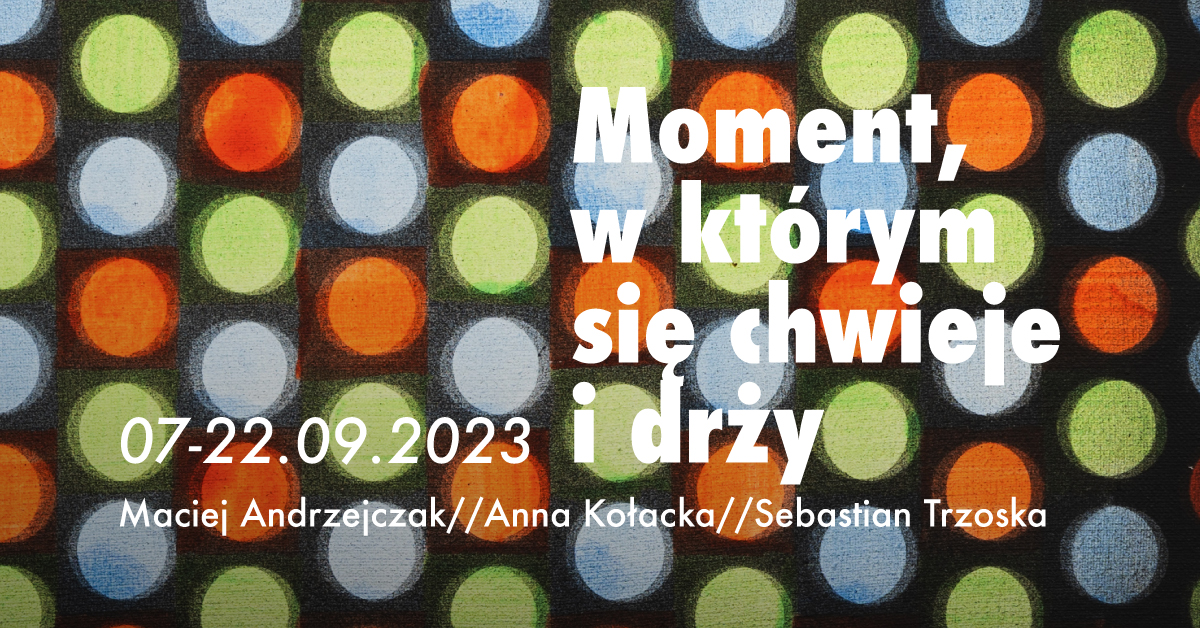The moment it wobbles and trembles
Venue: Gallery Szydłowski, 13/15 Nowolipie Str., Warsaw
Opening: 07.09.2023, 18:00-21:00
Duration: 07-22.09.2023
Maciej Andrzejczak, Anna Kołacka, Sebastian Trzoska
The clocks no longer stop, and the time displayed on the ubiquitous screens flows either too fast or too slow. The works of the three artists are like an experiment designed to recognize and experience a disordered reality.
Sebastian Trzoska’s Technical diagram for 24 hours of focus shows a stopwatch board speeding up minute by minute. On the one hand ”it is simply a form of creative play with the ruthless limitations of the timer’s function and the industrial nature of the object, such as a typical advertising display built from LED lights” (S.T). In this black-framed controlled chaos, where the concept of time is the building block of the artistic work, Trzoska finds a place full of inapparent meanings. The strange, mechanised rhythm hangs over us almost forever thanks to, among other things, the technology that penetrates our everyday life. At first glance, this appears to be a conspiracy against humanity, orchestrated by time, which slips through our fingers and the clock weighing down its smallest atom.
Another aspect of this experience is present in the works of Maciej Andrzejczak, who writes about his work: “While watching television images, I experienced a melancholic sensation of seeing nothing in particular. Consciousness of what I was looking at, i.e. the content of the television programme, ceased to exist, and in its place appeared a kind of emptiness; a sense of meaninglessness. A particular scene absorbed my attention utterly and at the same time stopped being important. I had a similar experience when scrolling through the Instagram app. Images there are like fireworks, consisting of a flash and a quick burnout. After seeing the whole waterfall of images, I felt that I hadn’t really seen anything” (M.A.). The works on display, entitled Screens, as well as Hot-Cold, are a result of artist’s experience. With his works he wants to put his viewer in a similar state of ‘hypnosis’ leading to a loss of track of time.
We find ourselves in what some call an ‘event society’. That is, a society as a collection of individuals for whom, due to the ubiquity and accessibility of technology, every imaginable “(…) sensory stimulus is available almost instantly in any quantity. We only lack the time to absorb them all”[1]. Thus, we are participants in a peculiar phenomenon: the digital screen and the hidden beyond infinite (macro-)horizon of compulsive pleasure, arousing terror or hyperactive procrastination, seizes the space of our everyday life and dictates its rhythm.
Like Sebastian Trzoska, Anna Kolacka also uses elements related to timekeeping to construct her artwork. In this case, she reverses the direction of the clock. In Kołacka’s Nano 1. Counterclockwise time there are two apparent layers. One is a constans. It is a carefully painted structure that may resemble minerals or distant reaches of space similar to those from Webb telescope images. The other layer consists of coloured structures that rotate centrifugally to the left. In a way we are trapped on the picture plane mesmerised by form patterns, which, just as fractal systems, seem to reach all the way to infinity. By juxtaposing a meditative animation with a painting on a canvas, the viewer is drawn into the centre of the experience, in which a painting transforms before their eyes.
Neurasthenic reflexes, developed as a result of uncontrolled interaction with technology, generate a surging dependence on digital systems and their user-friendly experiences. The user wants an instant access to information, seemingly limitless choice and a user-friendly interface supported by an ergonomic layout. In return, we spit out a psycho-physical gurgle (of dopamine, cortisol, serotonin and oxytocin), which unsurpassed algorithms process into an endless database about us, (not) for us.
We are a collection of events.
S.T.
M.A
A.K
[1]2009, New York Times, 5th December 2005, in: S. Klein, CZAS Przewodnik użytkownika, W. A. B. Publishing House, p. 167.

- Author: o.petrenko
- Published on: 04.09.2023, 12:07
- Last edit: 04.09.2023, 12:07

